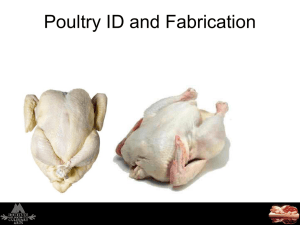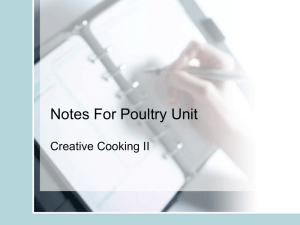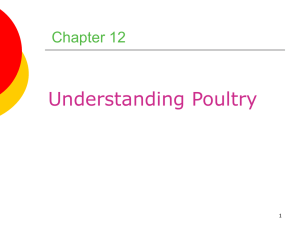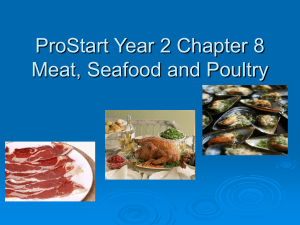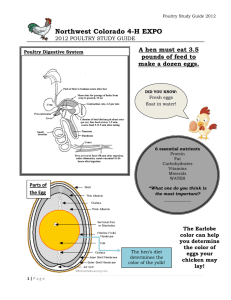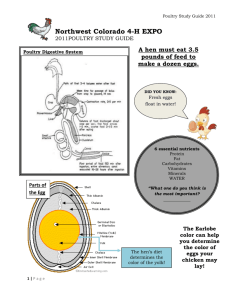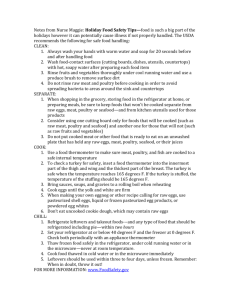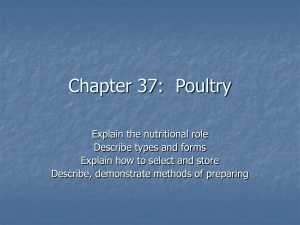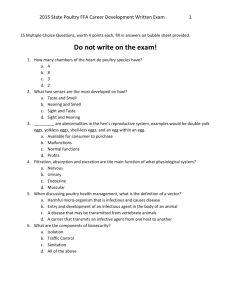Poultry ppt.
advertisement
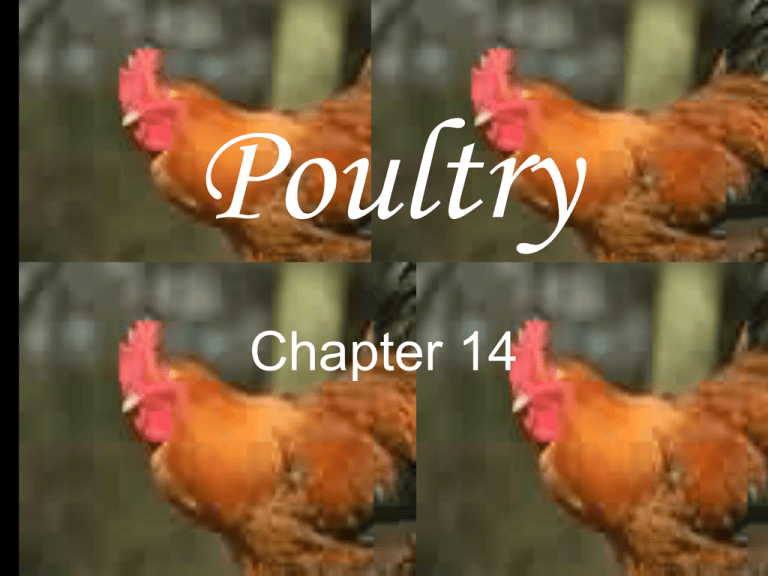
Poultry Chapter 14 Poultry Includes any domesticated bird. Chicken, turkey and duck are the most common. Types of Poultry Turkey Hen- female is 8-16 lbs. Tom- male is up to 24 lbs. Duck/Goose All dark meat and higher in fat Nutritional Value High-protein Good source of phosphorous, iron, thiamin, riboflavin, and niacin. Older birds=more fat Turkey and chicken are lower in total fat, sat.fat and calories than many cuts of red meat. Much fat is reduced by just Light Vs. Dark Meat? Depends on: Amount of exercise Oxygen is stored in the myoglobin in muscle tissue. The more exercise that it gets, the more oxygen that is stored. Legs are usually dark meat Buying Poultry Can purchase fresh, frozen, or in processed form. Inspection and Grading: All poultry sold between states must be federally inspected. Retailers find grade on tag clipped to the wing. Grading Grade A: full-fleshed and meaty with well-distributed fat. Few blemishes and pinfeathers Grade B & C: usually in processed products. Buying fresh and frozen Marketed young =tender and suitable for all cooking methods. Whole, cut in halves, wings, breasts, thighs. When purchasing chicken, allow ½ lb of meat per serving. (high muscle proportion) Turkey: 1/3-1/2 lb/serving Duck and geese: ½ lb/serving When buying poultry Choose birds with meaty breasts and legs, well-distributed fat, and blemish-free skin. Choose type that will suit your needs Look for solidly frozen birds Beware of dirty and torn wrappers and freezer burn (pale, dry, frosty areas) Buying processed poultry Turkey and chicken are available canned. More expensive than fresh or frozen May be whole, cut in pieces, boned, or used in items like chicken chow mein. Read labels CAREFULLY! Can contain turkey breast or chicken leg, which are fatty! Storing Poultry VERY perishable, except canned Proper storage important to inhibit the growth of salmonella. Refrigerator: remove store wrapping, rewrap loosely in wax paper. Place in coldest part of freezer and use w/in 2-3 days Longer storage: rewrap bird in moisture proof Doneness Meat thermometer-most accurate (165 degrees). No meat thermometer? Grab a drumstick, on a cooked bird the thigh joint will twist easily. Or prick the breast and clear liquid should come out. Methods… Roasting: place breast side up in shallow pan. season and cook to 165 degrees Broiling: split bird in halves or quarters. place on broiler, cook about 4-5 in. from heat source. Frying: roll pieces in flour, egg, and bread crumbs or dip in batter. Oven-frying: i.e. baking. cook in moderate heat Braising: brown in small amt. of fat. Add small amount of water and cover. cook over low heat and simmer Stewing: place in kettle and cover with water. can add veggies for flavor. Do not boil liquid. Microwave: can defrost or partially cook. bony pieces to center. Before cooking… Frozen Thaw before cooking in original wrapper in fridge or wrap in a tightly closed plastic bag and place in sink full of cold water. Change water every 30 min. Boning Taking bones out Boneless chicken more expensive Poultry Terms Dressed: Cleaned poultry ready to cook Giblits: edible internal organs, such as heart or liver. Often used as appetizers or soup flavor Trus: wing tips turned back onto the shoulder and drumsticks tied to tail Basting: spooning pan drippings over the top of poultry as it is cooked

